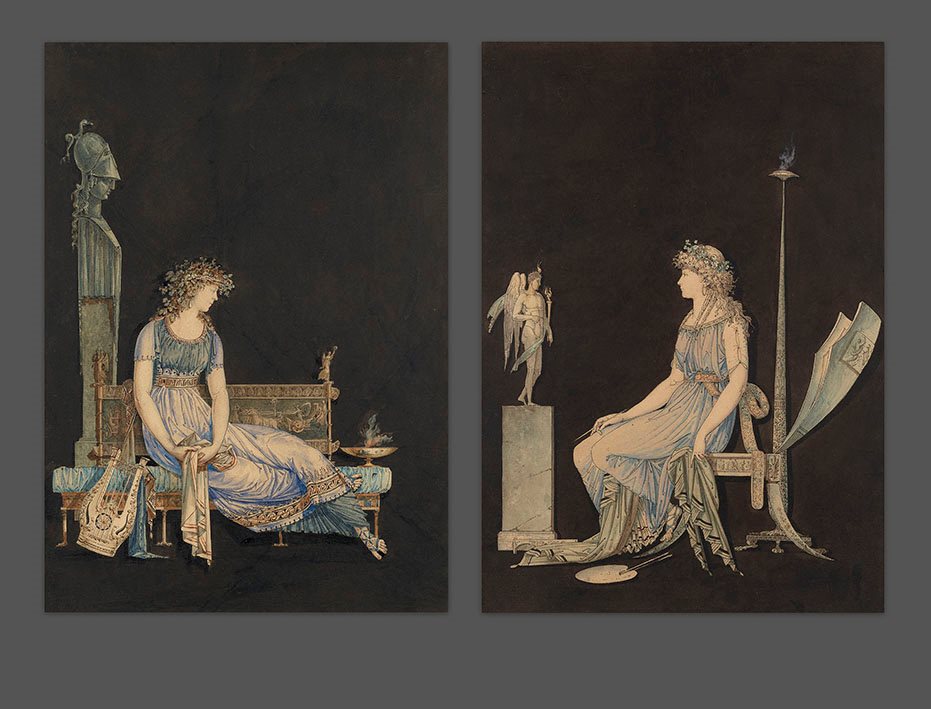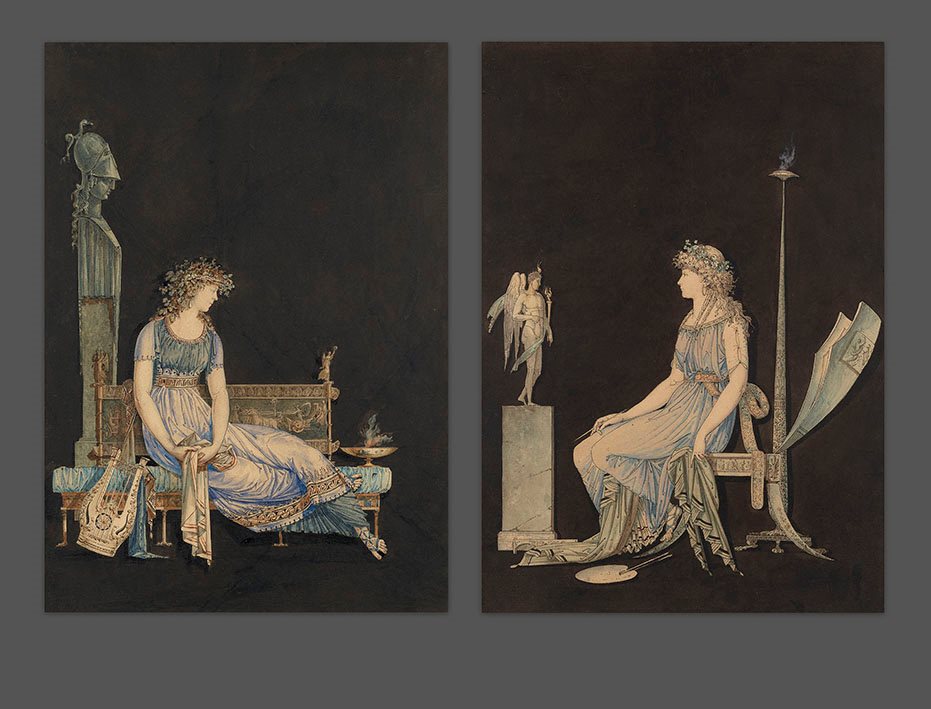

Provenance:
Private Collection, France
Charles Janoray, Paris, 2002
Private Collection, New York
According to Richard Campbell the present, recently rediscovered drawings are amongst some of the most highly finished drawings known by Moitte – one of France’s leading Neo-classical sculptors. Executed at the height of his career in his typical incisive line, they depict classical maidens representing allegories of the arts (painting and sculpture) and music. The classical female figure was a popular subject within the Neo-Classical canon (used to convey the moral virtuousness of the new Republic) and the present pair relate closely to Moitte’s most famous print designs Allegory of Liberty and the associated Allegory of Equality (1792-3).
Typical of his drawings of the 1790’s (which draw on classical motifs) Moitte, a bas-relief sculptor, has managed to express a wonderfully sculptural quality in the present pair of sheets. The sculptor conveys the mass of the figures and furnishings through the use of negative space – that of the white paper - left by the dark ground he applies to the background. This contrast is heightened by the precisely delineated drawing and jewel-like washes which he applies to the forms. A technique which is further heightened by Moitte’s ingenious depiction of the figures’ shadows, applied dark on dark to the background, which give the notion that we are looking at sculptures, displayed in niches.
Such works were intended to emulate the scenes of figures against dark backgrounds which had been discovered, frescoed on the walls of the recently exposed ruins at Pompeii. The popularity of such classical imagery, paired with Moitte’s gift for form and for translating the qualities of sculpture to paper, meant that his drawings were popular designs for engravers, keen to produce fond noir aquatints. His skilled draughtsmanship also meant that he found considerable success as a designer for silverware, working in particular with Robert-Joseph Auguste.
In 1768 he won the Prix de Rome for sculpture, having beforehand trained in the studio of renowned sculptor Jean-Baptiste Pigalle, and later in that of Jean-Baptiste Lemoyne. Subsequently whilst based in Rome, between 1771 and 1773 he found great inspiration in the antique. Indeed many of Moitte’s fond noirs such as the present works and also the Dionysian Frieze, seem to be in some part inspired by the Aldobrandini Wedding fresco which he would have seen in the Vatican collections. He would have also seen there the Sleeping Ariadne marble, from which the pose of Music in the present sheet appears to derive.
The elongated female figure first appeared in Moitte’s work in his decoration of the barrières (toll-houses) in Paris, constructed by the well-known architect Claude-Nicolas Ledoux between 1786-8. For the project Moitte had executed a series of allegorical maidens in 1:8 proportion (the same as our female figures) wearing peploes and crowns and with similar design elements (such as the gowns and their strict vertical drapery folds).
The present, well preserved Allegories are fine examples of neo-classical design. Rich in both invention and eloquent in quotation of the antique (as typified by elements such as the ornate gold lyre, the stylized kismos chair, the day bed and candelabra) they reflect not only Moitte’s consummate ability as a draughtsman, but also his great knowledge of antiquity. Representing the height of the fond noir style at the same time the present sheets are unusually intimate and less severe than some of Moitte’s other works. Notably the women have a contemporary French visage rather than a stern classical appearance. This makes the present sheets rather unique within the artist’s oeuvre and their informality suggests that they were of a more personal significance, possibly intended as a gift for a friend or close patron.
Typical of his drawings of the 1790’s (which draw on classical motifs) Moitte, a bas-relief sculptor, has managed to express a wonderfully sculptural quality in the present pair of sheets. The sculptor conveys the mass of the figures and furnishings through the use of negative space – that of the white paper - left by the dark ground he applies to the background. This contrast is heightened by the precisely delineated drawing and jewel-like washes which he applies to the forms. A technique which is further heightened by Moitte’s ingenious depiction of the figures’ shadows, applied dark on dark to the background, which give the notion that we are looking at sculptures, displayed in niches.
Such works were intended to emulate the scenes of figures against dark backgrounds which had been discovered, frescoed on the walls of the recently exposed ruins at Pompeii. The popularity of such classical imagery, paired with Moitte’s gift for form and for translating the qualities of sculpture to paper, meant that his drawings were popular designs for engravers, keen to produce fond noir aquatints. His skilled draughtsmanship also meant that he found considerable success as a designer for silverware, working in particular with Robert-Joseph Auguste.
In 1768 he won the Prix de Rome for sculpture, having beforehand trained in the studio of renowned sculptor Jean-Baptiste Pigalle, and later in that of Jean-Baptiste Lemoyne. Subsequently whilst based in Rome, between 1771 and 1773 he found great inspiration in the antique. Indeed many of Moitte’s fond noirs such as the present works and also the Dionysian Frieze, seem to be in some part inspired by the Aldobrandini Wedding fresco which he would have seen in the Vatican collections. He would have also seen there the Sleeping Ariadne marble, from which the pose of Music in the present sheet appears to derive.
The elongated female figure first appeared in Moitte’s work in his decoration of the barrières (toll-houses) in Paris, constructed by the well-known architect Claude-Nicolas Ledoux between 1786-8. For the project Moitte had executed a series of allegorical maidens in 1:8 proportion (the same as our female figures) wearing peploes and crowns and with similar design elements (such as the gowns and their strict vertical drapery folds).
The present, well preserved Allegories are fine examples of neo-classical design. Rich in both invention and eloquent in quotation of the antique (as typified by elements such as the ornate gold lyre, the stylized kismos chair, the day bed and candelabra) they reflect not only Moitte’s consummate ability as a draughtsman, but also his great knowledge of antiquity. Representing the height of the fond noir style at the same time the present sheets are unusually intimate and less severe than some of Moitte’s other works. Notably the women have a contemporary French visage rather than a stern classical appearance. This makes the present sheets rather unique within the artist’s oeuvre and their informality suggests that they were of a more personal significance, possibly intended as a gift for a friend or close patron.